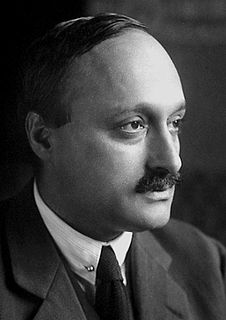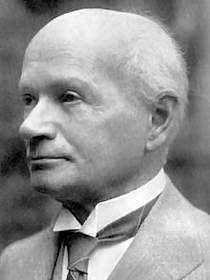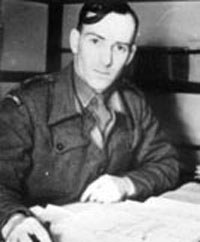Related Research Articles

Ferdinand Tönnies was a German sociologist, economist, and philosopher. He was a significant contributor to sociological theory and field studies, best known for distinguishing between two types of social groups, Gemeinschaft and Gesellschaft. He co-founded the German Society for Sociology together with Max Weber and Georg Simmel and many other founders. He was president of the society from 1909 to 1933, after which he was ousted for having criticized the Nazis. Tönnies was regarded as the first proper German sociologist and published over 900 works, contributing to many areas of sociology and philosophy. Tönnies, Max Weber, and Georg Simmel are considered the founding fathers of classical German sociology. Though there has been a resurgence of interest in Weber and Simmel, Tönnies has not drawn as much attention.

James Franck was a German physicist who won the 1925 Nobel Prize for Physics with Gustav Hertz "for their discovery of the laws governing the impact of an electron upon an atom". He completed his doctorate in 1906 and his habilitation in 1911 at the Frederick William University in Berlin, where he lectured and taught until 1918, having reached the position of professor extraordinarius. He served as a volunteer in the German Army during World War I. He was seriously injured in 1917 in a gas attack and was awarded the Iron Cross 1st Class.

Alfred Pringsheim was a German mathematician and patron of the arts. He was born in Ohlau, Prussian Silesia and died in Zürich, Switzerland.
The year 1933 in archaeology involved some significant events.

Antiquity is an academic journal dedicated to the subject of archaeology. It publishes six issues a year, covering topics worldwide from all periods. Its current editor is Robert Witcher, Associate Professor of Archaeology at the University of Durham. Since 2015, the journal has been published by Cambridge University Press.

Ludwig Traube was a German physician and co-founder of the experimental pathology in Germany.

Robert Lachmann was a German ethnomusicologist, polyglot, orientalist and librarian. He was an expert in the musical traditions of the Middle East, a member of the Berlin School of Comparative Musicology and one of its founding fathers. After having been forced to leave Germany under the Nazis in 1935 because of his Jewish background, he emigrated to Palestine and established a rich archive of ethnomusicological recordings for the Hebrew University of Jerusalem.
Aileen Mary Fox, Lady Fox, was an English archaeologist, who specialised in the archaeology of south-west England. She notably excavated the Roman legionary fortress in Exeter, Devon, after the Second World War.

The Northwest African cheetah, also known as the Saharan cheetah, is a cheetah subspecies native to the Sahara and the Sahel. It is listed as Critically Endangered on the IUCN Red List. In 2008, the population was suspected to number less than 250 mature individuals.

Gustaf Kossinna was a German philologist and archaeologist who was Professor of German Archaeology at the University of Berlin.
Arthur Lindo Patterson was a pioneering British X-ray crystallographer. Patterson was born to British parents in New Zealand in 1902. Shortly afterwards the family moved to Montreal, Canada and later to London, England. In 1920 Patterson moved to Canada for college at McGill University, Montreal. Firstly he concentrated on Mathematics and but then changed his major to Physics. He received his bachelor's degree in 1923 and a master's in 1924. His master's thesis was on the production of hard X-rays by interaction of radium β rays with solids.

Rupert Leo Scott Bruce-Mitford, FBA, FSA was a British archaeologist and scholar, best known for his multi-volume publication on the Sutton Hoo ship burial. He was a noted academic as the Slade Professor of Fine Art at Cambridge University from 1978 to 1979, in addition to appointments at All Souls College, Oxford, and Emmanuel College, Cambridge.
Julius von Borsody was an Austrian film architect and one of the most employed set designers in the Austrian and German cinemas of the late silent and early sound film periods. His younger brother, Eduard von Borsody, was a film director in Austria and Germany. He is also the great-uncle of German actress Suzanne von Borsody.
The German Mathematical Society is the main professional society of German mathematicians and represents German mathematics within the European Mathematical Society (EMS) and the International Mathematical Union (IMU). It was founded in 1890 in Bremen with the set theorist Georg Cantor as first president. Founding members included Georg Cantor, Felix Klein, Walther von Dyck, David Hilbert, Hermann Minkowski, Carl Runge, Rudolf Sturm, Hermann Schubert, and Heinrich Weber.
Ludwig Jost ForMemRS was a German botanist, and university professor.

The Gesellschaft zur Erhaltung alter und gefährdeter Haustierrassen or GEH is a German national association for the conservation of historic and endangered domestic animal breeds.

Begash in an archaeological site in the Koksu River valley in historic Zhetysu, Kazazkstan. The site is situated in piedmont steppes above the Zhalgyzagash River, a tributary of the Koksu River. The people of Begash were transhumant pastoralists who mainly herded sheep and goats. They likely used the site primarily as a place of winter residence. The people of Begash buried their dead first in cist and later in kurgan burials. So far, the earliest direct evidence for domesticated grains in Central Asia can be found at Begash, with the earliest evidence for the presence of both domesticated free-threshing wheat and broomcorn millet.

The Monument to the X-ray and Radium Martyrs of All Nations is a memorial in Hamburg, Germany, commemorating those who died due to their work with the use of radiation, particularly X-rays, in medicine. It was unveiled on the grounds of St Georg Hospital, on 4 April 1936 by the Deutsche Röntgengesellschaft.
Ian David Meadows is a British archaeologist. He has worked in archaeology for some 40 years, including as a Senior Project Officer at Northamptonshire Archaeology from 1992 to 2014. During that time he excavated a number of large quarries in England and Wales, and excavated the boar-crested Anglo-Saxon Pioneer Helmet in addition to discovering the first definitive evidence for viticulture in Roman Britain. He has also worked for the Museum of London Archaeology, and has taught archaeology and landscape history for Cambridge University, Anglia Ruskin University, the University of Bath, and the Workers' Educational Association.

Max Born was a widely influential German physicist and mathematician who was awarded the 1954 Nobel Prize in Physics for his pivotal role in the development of quantum mechanics. Born won the prize primarily for his contributions to the statistical interpretation of the wave function, though he is known for his work in several areas of quantum mechanics as well as solid-state physics, optics, and special relativity. Born's entry in the Biographical Memoirs of Fellows of the Royal Society included thirty books and 330 papers.
References
- ↑ Haltenorth, Theodor (1972). "Hilzheimer, Max". Neue Deutsche Biographie (in German). 9. p. 168.
- ↑ Hilzheimer, Max (1932). "Dogs". Antiquity. 6 (24): 411–419. doi:10.1017/S0003598X00007341.
- ↑ Hilzheimer, Max (1936). "The Inca bull-dog". Antiquity. 10 (39): 358–359. doi:10.1017/S0003598X00117764. ISSN 0003-598X.
- ↑ Hilzheimer, Max (1936). "Sheep". Antiquity. 10 (38): 195–206. doi:10.1017/S0003598X00011571.
- ↑ Ryder, M. L. (1982). "Sheep – Hilzheimer 45 years on". Antiquity. 56 (216): 15–23. doi:10.1017/S0003598X00044525.
- ↑ Hilzheimer, Max (1935). "The Evolution of the Domestic Horse". Antiquity. 9 (34): 133–139. doi:10.1017/S0003598X00010188.